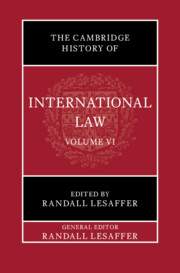Book contents
- The Cambridge History of International Law
- The Cambridge History of International Law
- Frontispiece
- The Cambridge History of International Law
- Copyright page
- Contents
- Plates
- Contributors
- Preface
- Abbreviations
- Part I International Law in Renaissance Europe (1492–1660)
- Part II International Law in Old Regime Europe (1660–1775)
- 12 The Law of Nations in Old Regime Europe
- 13 Territory and Jurisdiction in Old Regime Europe
- 14 The Law of the Sea in Old Regime Europe
- 15 War and the Use of Force in Old Regime Europe
- 16 Warfare on land in Old Regime Europe
- 17 Maritime Warfare in Old Regime Europe
- 18 Peacemaking in Old Regime Europe
- 19 Trade in Old Regime Europe
- 20 Diplomacy in Old Regime Europe
- 21 Dispute Settlement in Old Regime Europe
- 22 The Ottoman Encounter and the Law of Nations in the Old Regime
- Index
- Plate Section (PDF Only)
- References
21 - Dispute Settlement in Old Regime Europe
from Part II - International Law in Old Regime Europe (1660–1775)
Published online by Cambridge University Press: 22 April 2025
- The Cambridge History of International Law
- The Cambridge History of International Law
- Frontispiece
- The Cambridge History of International Law
- Copyright page
- Contents
- Plates
- Contributors
- Preface
- Abbreviations
- Part I International Law in Renaissance Europe (1492–1660)
- Part II International Law in Old Regime Europe (1660–1775)
- 12 The Law of Nations in Old Regime Europe
- 13 Territory and Jurisdiction in Old Regime Europe
- 14 The Law of the Sea in Old Regime Europe
- 15 War and the Use of Force in Old Regime Europe
- 16 Warfare on land in Old Regime Europe
- 17 Maritime Warfare in Old Regime Europe
- 18 Peacemaking in Old Regime Europe
- 19 Trade in Old Regime Europe
- 20 Diplomacy in Old Regime Europe
- 21 Dispute Settlement in Old Regime Europe
- 22 The Ottoman Encounter and the Law of Nations in the Old Regime
- Index
- Plate Section (PDF Only)
- References
Summary
The chapter gives an overview of dispute settlement during the Old Regime. Contrary to older assessments of the historiography, dispute settlement retained its importance in this era, both in qualitative and in quantitative terms. This was true for the field of theoretical literatures, which, from the last decades of the seventeenth century, dealt intensively with the subject. Normally, a clear distinction was made between an elected arbiter, who definitively decided a dispute, and a mediator, who only made peace proposals. Diplomatic practice, which made intensive use of the instruments of dispute settlement until the last decades of the eighteenth century, was much more flexible. The transitions between arbitration and mediation were fluid; the boundaries of confession and rank were also frequently crossed. In Old Regime Europe, mediation was also used for the first time in peace negotiations between Christian and Islamic powers. New forms of mediation emerged as well. One was the armed mediation, in which a power intervened in a conflict uninvited and set a peace ultimatum; this could easily lead to war. This indicates that dispute settlement did not automatically contribute to an increase in peace; the relationship of dispute settlement to war and peace remained rather ambivalent in Old Regime Europe.
- Type
- Chapter
- Information
- The Cambridge History of International Law , pp. 682 - 710Publisher: Cambridge University PressPrint publication year: 2025

